Menu
Physics Lesson 13.2.7 - Types of Thermometers
Please provide a rating, it takes seconds and helps us to keep this resource free for all to use
Welcome to our Physics lesson on Types of Thermometers, this is the seventh lesson of our suite of physics lessons covering the topic of Thermal Expansion, you can find links to the other lessons within this tutorial and access additional physics learning resources below this lesson.
Types of Thermometers
All thermometers except digital (electronic) thermometers use the property of thermal expansion (contraction) to measure the temperature. Below, we will briefly explain the construction and the operating principle of all types of thermometers available.
a) Clinical thermometer.
It is used to measure the temperature of human body. A clinical thermometer uses the expanding property of mercury, whose level rises or drops in a narrow column according the body temperature. Therefore, mercury here acts as a capillary liquid.
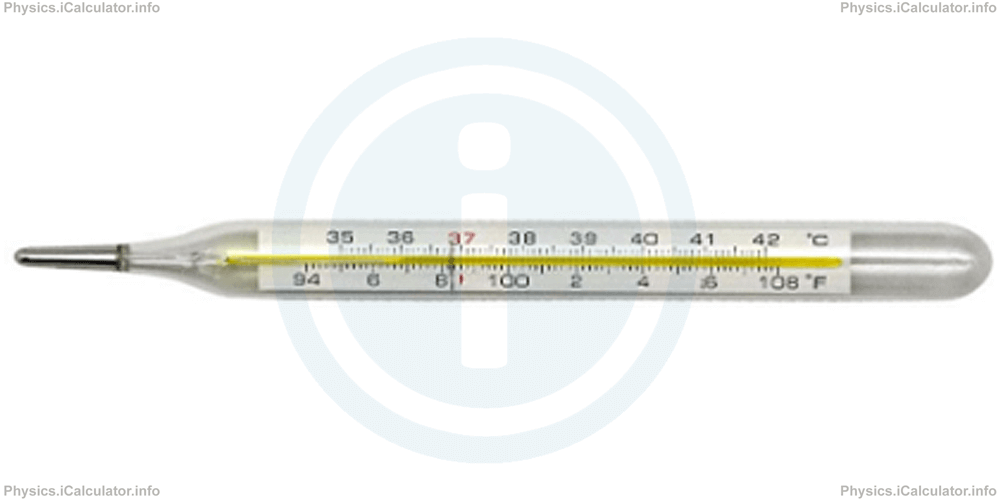
The range of most clinical thermometers varies from 35°C to 42°C as the body temperature of a healthy person is typically about 37°C.
b) Household (home) thermometer.
Since the range of air temperatures are wider than those of the human body this thermometer uses (coloured) alcohol instead of mercury as capillary liquid. (Colour is used to make the reading more visible as alcohol itself is colourless). Alcohol thermometers are used instead of mercury thermometers in very cold regions because alcohol has a lower freezing point than mercury. If mercury freezes, it won't move in the tube, so a liquid that has a freezing point that is lower than the temperature it is measuring must be used for this purpose.
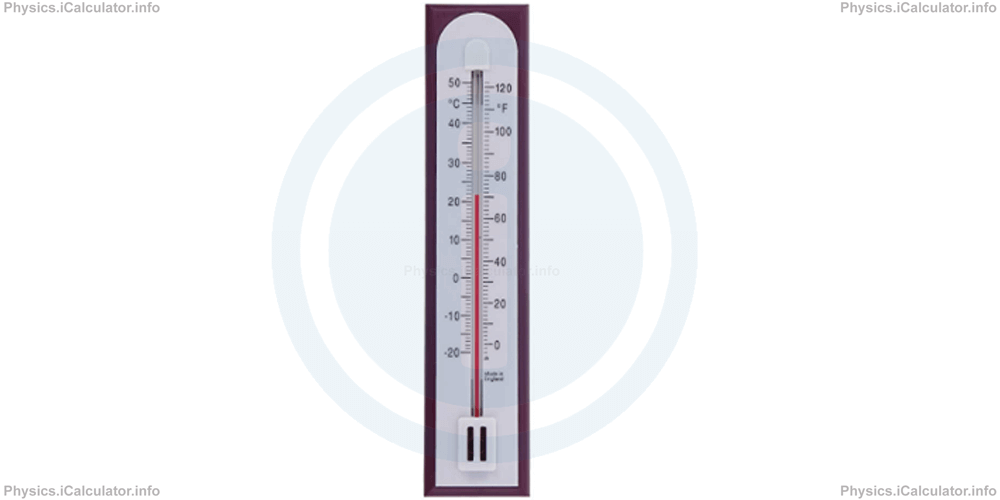
The range of most room thermometers varies from -30°C to + 50°C.
c) Lab thermometer.
This kind of thermometer must have a much wider range than room thermometers as it is used in various thermal and chemical processes, which involve many substances that are not commonly used in daily life.
Below, a lab thermometer that uses colored alcohol as capillary liquid is shown.
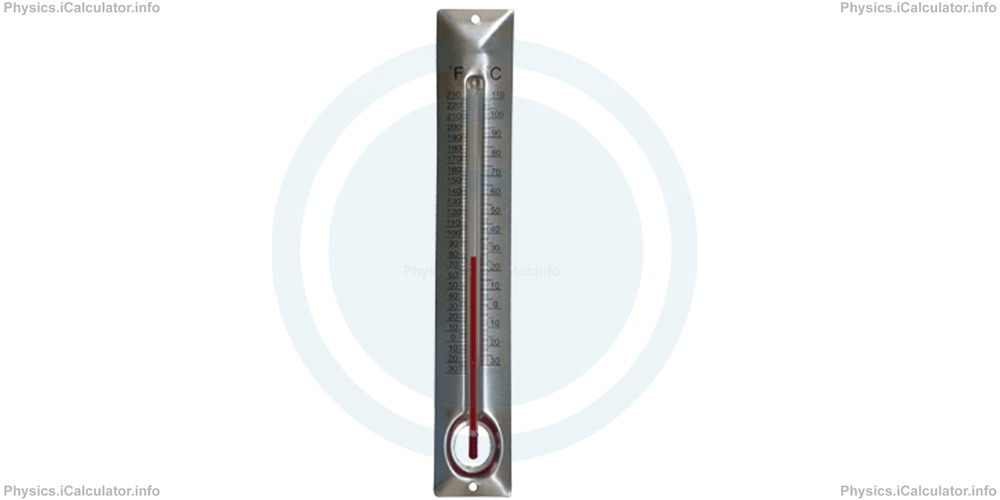
Lab thermometers contain a variety of capillary liquids and ranges but the most typical capillary liquid is alcohol and their range usually varies between -50°C to 250°C.
d) Metallic thermometer.
This kind of thermometer is used to measure the temperature of melting metals, so its range must be very wide. We cannot use glass as cover or mercury and alcohol as capillary liquids because they cannot resist to such high temperatures. (For example, iron melts at about 1600°C). Therefore, a completely different technique must be used for this purpose.
Most metallic thermometers constructors use the properties of bimetallic strip to measure the temperatures of very hot objects. A round bimetallic strip with a pointer at its end is placed on a metal end, which is placed in contact with the hot object. Since heat travels through metal, it reaches the bimetallic strip making it bend more than when it is cold. Then, a temperature scaling is made accordingly, producing a new type of thermometer, which uses a completely different technique compared to the other types of thermometers explained earlier.
A simple scheme of a metallic thermometer is shown below.
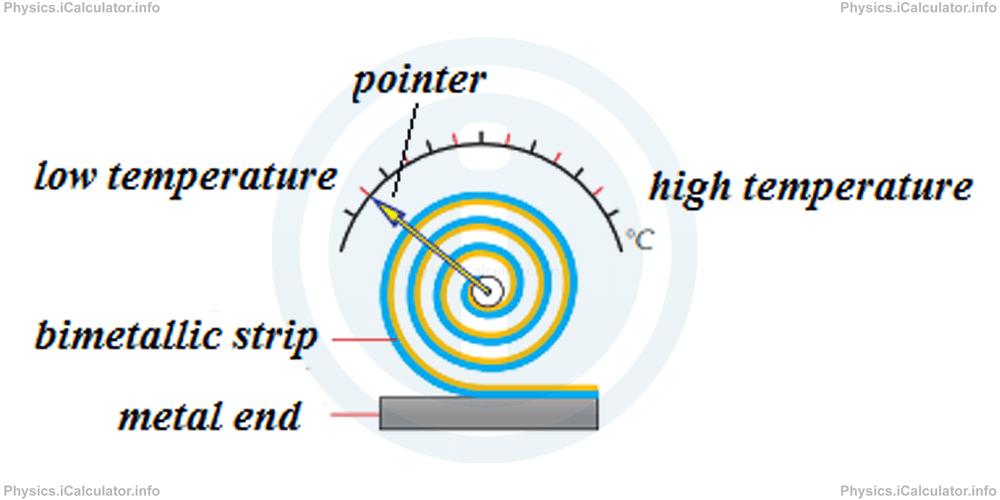
The range of metal thermometers typically varies from -200°C to +1600°C.
e) Digital thermometer.
This kind of thermometer uses the digital technology to convert the heat energy into electric energy. There are two main types of digital thermometers: contact thermometers, which are operated in a similar way to clinical ones, and infra-red (contactless) thermometers which are operated remotely, in a similar way to remote controls.
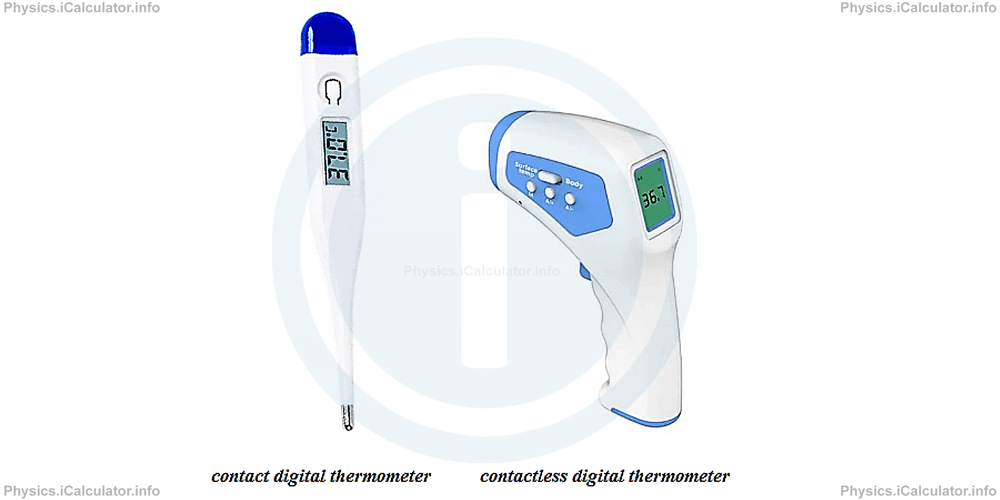
Digital thermometers use the fact that hotter the object, more infrared radiation it emits. This radiation is converted by the thermometer's software into digital values accordingly.
Example 5
A technician wants to measure the temperature of a liquid substance that is hotter than the temperature of boiling water (100°C). Which thermometer is more suitable for this purpose?
Solution 5
Thermometers such as home, clinical and digital thermometers are excluded as options because they have narrow ranges of temperature measurements. Therefore, only metallic and lab thermometers do remain as possible options. However, metallic thermometers are not so finely graded since they include a wide range of temperatures. Therefore, lab thermometers are more suitable for this purpose.
You have reached the end of Physics lesson 13.2.7 Types of Thermometers. There are 7 lessons in this physics tutorial covering Thermal Expansion, you can access all the lessons from this tutorial below.
More Thermal Expansion Lessons and Learning Resources
Whats next?
Enjoy the "Types of Thermometers" physics lesson? People who liked the "Thermal Expansion lesson found the following resources useful:
- Thermometers Feedback. Helps other - Leave a rating for this thermometers (see below)
- Thermodynamics Physics tutorial: Thermal Expansion. Read the Thermal Expansion physics tutorial and build your physics knowledge of Thermodynamics
- Thermodynamics Revision Notes: Thermal Expansion. Print the notes so you can revise the key points covered in the physics tutorial for Thermal Expansion
- Thermodynamics Practice Questions: Thermal Expansion. Test and improve your knowledge of Thermal Expansion with example questins and answers
- Check your calculations for Thermodynamics questions with our excellent Thermodynamics calculators which contain full equations and calculations clearly displayed line by line. See the Thermodynamics Calculators by iCalculator™ below.
- Continuing learning thermodynamics - read our next physics tutorial: Absorption of Heat
Help others Learning Physics just like you
Please provide a rating, it takes seconds and helps us to keep this resource free for all to use
We hope you found this Physics lesson "Thermal Expansion" useful. If you did it would be great if you could spare the time to rate this physics lesson (simply click on the number of stars that match your assessment of this physics learning aide) and/or share on social media, this helps us identify popular tutorials and calculators and expand our free learning resources to support our users around the world have free access to expand their knowledge of physics and other disciplines.
Thermodynamics Calculators by iCalculator™
- Carnot Engine Efficiency Calculator
- Entropy Calculator
- Gas Laws Calculator
- Molecular Mean Free Path Calculator
- Translational Kinetic Energy Of Gas Calculator
- Root Mean Square Speed Calculator
- Ideal Gas Law Calculator
- Change In The Gas Internal Energy Calculator
- Radiative Heat Transfer Calculator
- Evaporative Heat Transfer Calculator
- Convective Heat Transfer Calculator
- Conductive Heat Transfer Calculator
- Final Temperature Of Mixture Calculator
- Heat Absorbed Or Released Calculator
- Thermal Expansion Calculator
- Temperature Calculator